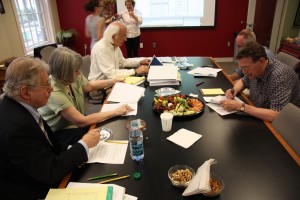 Why does the Washington Monument — the defining feature of the Washington, D.C., skyline and the centerpiece of the National Mall — remain unfinished and underutilized at ground level? Whose ideas have shaped the Mall? What should the grounds look like? Who should get to decide? Discover the history of the grounds and see a series of groundbreaking ideas selected by a jury of distinguished designers, historians, a Washington cultural leader, and a futurist at the Virginia Center for Architecture’s newest exhibition Someday in the Park with George: The National Ideas Competition for the Washington Monument Grounds. The exhibition is on display at the Virginia Center for Architecture from April 12 through June 24, 2012.
Why does the Washington Monument — the defining feature of the Washington, D.C., skyline and the centerpiece of the National Mall — remain unfinished and underutilized at ground level? Whose ideas have shaped the Mall? What should the grounds look like? Who should get to decide? Discover the history of the grounds and see a series of groundbreaking ideas selected by a jury of distinguished designers, historians, a Washington cultural leader, and a futurist at the Virginia Center for Architecture’s newest exhibition Someday in the Park with George: The National Ideas Competition for the Washington Monument Grounds. The exhibition is on display at the Virginia Center for Architecture from April 12 through June 24, 2012.
Explore the history of the Monument and its grounds, from funding shortages and political disagreements that left the Monument unfinished for nearly 50 years, to the numerous planning and design challenges posed by the site. Discover how Peter Charles L’Enfant and Thomas Jefferson differed in their visions for a monument to the nation’s first president, and find out why early plans for the grounds didn’t work. Add the need to address post-9-11 security concerns to poor geologic conditions, a location on a flood plain at the heart of a living city, and a lack of mature trees, and you begin to understand why a series of ad hoc solutions have been implemented rather than a cohesive plan.
More than 500 participants from across the U.S. and around the world submitted their proposals to address these challenges to the National Ideas Competition for the Washington Monument Grounds, which was launched nearly two years ago. “The National Ideas Competition is an ideal way to spark new thinking from citizens and professionals about this hugely important symbolic space. With fresh, visionary thought the Washington Monument grounds could one day become the real heart of the nation, not necessarily in the way L’Enfant or the McMillan planners envisioned it but in a new way that speaks to the aspirations of the 21st century,” says Kirk Savage, winner of the 2010 Charles C. Eldredge Prize for Distinguished Scholarship in American Art, Smithsonian American Art Museum. The competition was conceived by an independent steering committee including James P. Clark, FAIA, Adele Ashkar, ASLA , Lisa Benton-Short, Kenneth R. Bowling, Kent Cooper, FAIA, Judy Scott Feldman, Ph.D., Richard Longstreth, Ph.D. and Ellen Goldstein.
Someday in the Park with George was developed by a team of graduate students from the Museum Studies Program at George Washington University under the leadership of Professor Laura Schiavo.
The Virginia Center for Architecture itself has a strong tie to the National Mall. Its home since 2003 is the 27,000-square-foot Tudor-Revival residence built by architect John Russell Pope in 1919. Pope also designed the Thomas Jefferson Memorial, the National Archives, and the West Wing of the National Gallery of Art in Washington, D.C.
The exhibition debuts with an Opening Reception from 5:30-7:30 p.m. on Thursday, April 12. Call (804) 644-3041, ext. 100 or email aliguori@aiava.org to register to attend. There is no charge to attend the Opening Reception.
The Virginia Center for Architecture is located at 2501 Monument Avenue in Richmond, Virginia’s historic Fan District. The Center is open to the public Tuesday through Friday from 10 a.m. to 5 p.m.; Saturday and Sunday from 1 to 5 p.m. There is no charge for admission. Learn more at www.virginiaarchitecture.org.

